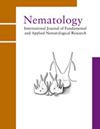Geographical distribution and phylogenic relationships of Hirschmanniella diversa Sher (Nematoda: Pratylenchidae) in Japan
IF 1.2
4区 生物学
Q2 ZOOLOGY
引用次数: 0
Abstract
Hirschmanniella diversa and H. imamuri parasitise the lotus, Nelumbo nucifera. Hirschmanniella spp. are the most important pests of lotus cultivation in Japan, but the distribution and species dominancy are not fully understood. In this study, we aimed to collect Hirschmanniella spp. individuals from lotus roots in the major lotus cultivation areas in Japan and identify them morphologically and molecularly using the 18S, D2-D3 regions of rRNA and mitochondrial cytochrome c oxidase subunit I (mtCOI). Hirschmanniella oryzae, commonly known to cause damage on rice in Japan, was also obtained and analysed for inter- and intraspecies sequence variations. All individuals of the genus Hirschmanniella extracted from lotus roots in 16 fields in ten prefectures were identified as H. diversa morphologically and molecularly. This result revealed that H. diversa is a dominant Hirschmanniella species parasitising lotus in Japan. Meanwhile, intraspecific sequence variations in H. diversa were relatively higher in the mtCOI (1-21 bases, ≦5.3%) than in the 18S rRNA and D2-D3 of 28S rRNA (0.0-0.3% and 0.0-0.4%, respectively) and in those of H. oryzae. Based on the mtCOI sequences, five haplotypes were identified and each haplotype was distributed in relatively close regions or regions in which the same lotus cultivars were grown, although further studies are required to verify this assertion. The morphological and genetic variations were higher in H. diversa than in H. oryzae (no intraspecific sequence variation in mtCOI), suggesting that H. diversa was not a recent invasive species.日本异曼氏Hirschmanniella diversa Sher的地理分布及系统发育关系(线虫纲:扇叶线虫科)
多样性赫氏菌和伊玛目H.imamuri寄生在莲藕上。日本荷花栽培中最主要的害虫是赫氏菌(Hirschmaniella spp.),但其分布和物种优势尚不完全清楚。在本研究中,我们旨在从日本主要荷花种植区的莲藕中收集Hirschmaniella spp.个体,并使用rRNA的18S、D2-D3区域和线粒体细胞色素c氧化酶亚基I(mtCOI)对其进行形态和分子鉴定。在日本,人们通常会对水稻造成损害,也获得并分析了种间和种内序列变异。从10个县、16个地的莲藕中提取的Hirschmaniella属所有个体在形态和分子上都被鉴定为H.diversa。这一结果表明,H.diversa是寄生在日本荷花上的一个优势Hirschmaniella种。同时,与18S rRNA和28S rRNA的D2-D3(分别为0.0-0.3%和0.0-0.4%)以及稻瘟病菌相比,在mtCOI中(1-21个碱基,≤5.3%)的种内序列变异相对较高。基于mtCOI序列,鉴定出五种单倍型,每个单倍型分布在相对较近的地区或种植相同莲花品种的地区,尽管还需要进一步的研究来验证这一说法。形态和遗传变异在稻瘟病菌中高于稻瘟病菌(mtCOI中没有种内序列变异),表明稻瘟病菌不是最近入侵的物种。
本文章由计算机程序翻译,如有差异,请以英文原文为准。
求助全文
约1分钟内获得全文
求助全文
来源期刊

Nematology
生物-动物学
CiteScore
2.60
自引率
33.30%
发文量
67
审稿时长
3 months
期刊介绍:
Nematology is an international journal for the publication of all aspects of nematological research (with the exception of vertebrate parasitology), from molecular biology to field studies. Papers on nematode parasites of arthropods, and on soil free-living nematodes, and on interactions of these and other organisms, are particularly welcome. Research on fresh water and marine nematodes is also considered when the observations are of more general interest.
Nematology publishes full research papers, short communications, Forum articles (which permit an author to express a view on current or fundamental subjects), perspectives on nematology, and reviews of books and other media.
 求助内容:
求助内容: 应助结果提醒方式:
应助结果提醒方式:


